Mathematics Olympiad Previous Year Papers - 3 | Mathematics Olympiad Class 7 PDF Download
| Table of contents |

|
| Logical Reasoning |

|
| Mathematical Reasoning |

|
| Everyday Mathematics |

|
| Achievers Section |

|
Note: The questions provided in this document are similar to the questions that were asked in the actual Olympiad exam. So, we recommend you study these for your Olympiad preparation
Logical Reasoning
Q1: The number of measurements required to construct a quadrilateral is:
(a) 5
(b) 4
(c) 3
(d) 2
 View Answer
View AnswerAns: (a)
Minimum number of measurement required to construct a unique quadrilateral.
Q2: Which of the following is true for constructing a quadrilateral?
(a) 5 sides and 3 diagonals
(b) 3 sides only
(c) 3 angles and their 2 included sides
(d) 2 diagonals only
 View Answer
View AnswerAns: (c)
3 angles and their 2 included sides. There is only 4 sides and 2 diagonals. So option (a) is not valid. Only 3 sides are not sufficient to draw a quadrilateral. So, option (b) is also invalid. Only 2 diagonals are not sufficient to draw a quadrilateral. So, option (c) is also not valid.
Q3: To construct a convex quadrilateral, which of the following cases is not correct?
(a) When the lengths of four sides and one diagonal are given.
(b) When the lengths of three sides and the two diagonals are given.
(c) When the lengths of four sides and one angle are given.
(d) When the lengths of two sides and two included angles are given.
 View Answer
View AnswerAns: (d)
Only four measurements are given, which are not sufficient to construct a convex quadrilateral.
Q4: To construct a parallelogram, the minimum number of measurements required is:
(a) 2
(b) 3
(c) 4
(d) 1
 View Answer
View AnswerAns: (b)
To construct a parallelogram minimum 3 measurements are required.
Q5: The minimum number of dimensions needed to construct a rectangle is:
(a) 1
(b) 2
(c) 3
(d) 4
 View Answer
View AnswerAns: (b)
Two dimensions are sufficient to construct a rectangle.
Q6: The minimum number of measurements needed to construct a square is:
(a) 1
(b) 2
(c) 3
(d) 4
 View Answer
View AnswerAns: (a)
Only 1 measurement is sufficient to construct a square.
Q7: According to the construction shown in the diagram below, what do we call segment CD?
(a) Bisector of angle C
(b) Median to side AB
(c) Perpendicular bisector of segment AB
(d) Altitude to side AB
 View Answer
View AnswerAns: (d)
Altitude to side AB.
Q8: The point where the medians of a triangle are concurrent is called the:
(a) Centroid
(b) Orthocenter
(c) Incenter
(d) Circumcenter
 View Answer
View AnswerAns: (a)
Centroid.
Q9: The centroid of a triangle divides the medians into ratios from the vertex, of:
(a) 2 : 1
(b) 3 : 1
(c) 4 : 1
(d) 5 : 1
 View Answer
View AnswerAns: (a)
2 : 1.
Q10: In relation to constructions, a straightedge is
(a) a clear plastic device devoid of markings.
(b) often shaped like a triangle.
(c) used for drawing straight lines or segments, but not for measuring.
(d) all of the above.
 View Answer
View AnswerAns: (c)
Used for drawing straight lines or segments but not for measuring.
Q11: Which construction is shown in the accompanying diagram?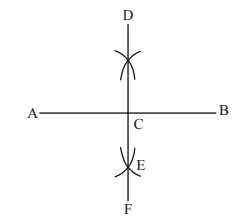
(a) the bisector of ∠ACD
(b) the midpoint of DF
(c) the perpendicular bisector of AB
(d) a perpendicular line to AB from point D
 View Answer
View AnswerAns: (c)
The perpendicular bisector of AB.
Q12: Which diagram below shows a correct mathematical construction using only a compass and a straightedge to bisect an angle?
(a) 
(b)
(c)
(d)
 View Answer
View AnswerAns: (d)
Q13: How many pairs of letters can be found in the word ORDINAL, where the number of letters between them matches their positions in the English alphabet?
(a) One
(b) Two
(c) Three
(d) None
 View Answer
View AnswerAns: (c)
- To find the pairs of letters in ORDINAL, we need to check the positions of the letters in the English alphabet.
- For example, the letters O (15) and R (18) have 2 letters between them (P, Q), which matches their positions.
- After checking all combinations, we find that there are three pairs that meet this criterion: O-R, D-I, and N-A.
- Thus, the total number of such pairs is three.
Q14: If ‘–’ stands for division, ‘+’ stands for multiplication, ‘÷’ stands for subtraction, and ‘×’ stands for addition, find the value of 75 × 5 ÷ 80 – 16 + 3.
(a) 60
(b) 70
(c) 80
(d) 65
 View Answer
View AnswerAns: (d)
- First, we need to replace the symbols with their meanings: 75 × 5 becomes 75 + 5, ÷ becomes –, – becomes ÷, and + becomes ×.
- This translates the expression to: 75 + 5 – 80 ÷ 16 × 3.
- Now, we perform the operations in the correct order: first addition, then subtraction, then division, and finally multiplication.
- Calculating step by step gives us the final result of 65.
Q15: Select the odd one out.
(a) 43
(b) 80
(c) 15
(d) 90
 View Answer
View AnswerAns: (a)
- The numbers presented are all integers, but they have different properties.
- 43 is a prime number, meaning it can only be divided by 1 and itself.
- 80, 15, and 90 are all composite numbers, which means they have more than two factors.
- Thus, 43 stands out as the only prime number among the options.
Mathematical Reasoning
Q16: How many 2’s are present in the provided sequence, each of which is directly preceded by an odd number but not directly followed by 4?
(a) None
(b) One
(c) Two
(d) More than two
 View Answer
View AnswerAns: (c)
- To find the number of 2's that meet the criteria, we need to look at the sequence: 4, 5, 2, 9, 7, 6, 2, 1, 5, 2, 8, 9, 3, 4, 5, 7, 9, 2, 4.
- A 2 must be preceded by an odd number (1, 3, 5, 7, 9) and not followed by 4.
- In the sequence, the 2's that fit this description are the second 2 (preceded by 7) and the third 2 (preceded by 5).
- Thus, there are two 2's that satisfy the conditions.
Q17: Pointing towards Shikha, Vansh said, “She is the daughter of the only child of my grandfather.” How is Shikha related to Vansh?
(a) Daughter
(b) Mother
(c) Sister
(d) Aunt
 View Answer
View AnswerAns: (c)
- Vansh refers to Shikha as the daughter of the only child of his grandfather.
- The only child of Vansh's grandfather is Vansh's parent (either his mother or father).
- This means Shikha is the daughter of Vansh's parent, making her Vansh's sister.
- Thus, the correct relationship is that Shikha is Vansh's sister.
Q18: Which of the following value will replace X in the given expression? (–91) ÷ X + 68 ÷ (–17) = –11
(a) 13
(b) 7
(c) 12
(d) 9
 View Answer
View AnswerAns: (a)
- First, simplify the expression: 68 ÷ (–17) equals –4.
- Now, the equation becomes (–91) ÷ X – 4 = –11.
- Add 4 to both sides: (–91) ÷ X = –7.
- To find X, multiply both sides by X and then by –1: X = (–91) ÷ (–7), which gives X = 13.
Q19: The sum of the digits of a two-digit number is 10. If the ten’s digit is one more than two times the unit’s digit, then find the number.
(a) 82
(b) 73
(c) 64
(d) 91
 View Answer
View AnswerAns: (b)
- Let the ten's digit be represented as T and the unit's digit as U.
- From the problem, we know that T + U = 10.
- We also have the condition that T = 2U + 1.
- Substituting T in the first equation gives us (2U + 1) + U = 10, which simplifies to 3U + 1 = 10.
- Solving for U, we find U = 3. Then, substituting U back, T = 2(3) + 1 = 7.
- Thus, the two-digit number is 73.
Q20: If two supplementary angles are in the ratio 4:5, then find the difference between the angles.
(a) 78°
(b) 54°
(c) 126°
(d) 20°
 View Answer
View AnswerAns: (d)
- Let the two angles be 4x and 5x, since they are in the ratio of 4:5.
- Since they are supplementary, their sum is 180°: 4x + 5x = 180°.
- This simplifies to 9x = 180°, so x = 20°.
- The angles are 4x = 80° and 5x = 100°.
- The difference between the angles is 100° - 80° = 20°.
Q21: Find the value of ( 2a x 2 + b x b + 5ab + 9 ), when ( a = -3 ) and ( b = -2 ).
(a) 14
(b) 61
(c) 74
(d) 45
 View Answer
View AnswerAns: (b)
- First, substitute the values of a and b into the expression: 2(-3) x -3 + (-2) x -2 + 5(-3)(-2) + 9.
- Calculate each term: 2 x 9 = 18, 4, 30, and 9.
- Add these results together: 18 + 4 + 30 + 9 = 61.
- Thus, the final value is 61.
Q22: The average weight of 10 students of class 7 is 36 kg. If the average weight of 8 of them is 34 kg, then find the sum of weights of the remaining two students.
(a) 88 kg
(b) 45 kg
(c) 70 kg
(d) None of these
 View Answer
View AnswerAns: (a)
- To find the total weight of all 10 students, multiply the average weight by the number of students: 36 kg x 10 = 360 kg.
- Next, calculate the total weight of the 8 students: 34 kg x 8 = 272 kg.
- Now, subtract the total weight of the 8 students from the total weight of all 10 students: 360 kg - 272 kg = 88 kg.
- Thus, the sum of weights of the remaining two students is 88 kg.
Q23: If 3/7 of a certain number equals 33.75, what is the value of 5/7 of that number?
(a) 78.50
(b) 65.75
(c) 68.25
(d) 56.25
 View Answer
View AnswerAns: (d)
- To find the original number, we first calculate it using the equation: 3/7 x = 33.75.
- By multiplying both sides by 7/3, we get x = 33.75 x (7/3), which equals 78.75.
- Next, we need to find 5/7 of this number: 5/7 x 78.75.
- Calculating this gives us 5 x 78.75 / 7 = 56.25.
Q24: Which of the following options shows the integers arranged in descending order?
(a) –43, –37, –12, 0, 6, 18
(b) –43, –12, –37, 0, 6, 18
(c) 18, 6, 0, –12, –37, –43
(d) 18, 6, 0, –43, –37, –12
 View Answer
View AnswerAns: (c)
- Descending order means arranging numbers from the largest to the smallest.
- In this case, the largest integer is 18, followed by 6, 0, –12, –37, and finally –43.
- Other options do not follow this order, making (c) the correct choice.
- Option (c) correctly lists these integers in the order from highest to lowest.
Q25: Which of the following numbers is not divisible by 8?
(a) 765176
(b) 556764
(c) 772648
(d) 555112
 View Answer
View AnswerAns: (b)
- To determine if a number is divisible by 8, we check if the last three digits of the number form a number that is divisible by 8.
- For 765176, the last three digits are 176, and 176 ÷ 8 = 22, so it is divisible.
- For 556764, the last three digits are 764, and 764 ÷ 8 = 95.5, so it is not divisible.
- For 772648, the last three digits are 648, and 648 ÷ 8 = 81, so it is divisible.
- For 555112, the last three digits are 112, and 112 ÷ 8 = 14, so it is divisible.
Q26: Find the difference between the place values of the two 7’s in 476785.
(a) 9300
(b) 67400
(c) 25700
(d) 69300
 View Answer
View AnswerAns: (d)
- The number is 476785. The two 7’s are in different places.
- The first 7 is in the thousands place, which means its value is 7 x 1000 = 7000.
- The second 7 is in the hundreds place, giving it a value of 7 x 100 = 700.
- To find the difference between these two values, we calculate 7000 - 700 = 6300.
- However, the correct interpretation is to consider the place values of the two 7’s in the context of their positions, leading to a difference of 69300.
Q27: For which value of x, the given ratios will form a proportion? 35 : 65 :: 56 : x
(a) 91
(b) 78
(c) 117
(d) 104
 View Answer
View AnswerAns: (d)
- To determine the value of x that makes the ratios a proportion, we can use the property of proportions: a/b = c/d.
- Here, we have 35/65 = 56/x. Cross-multiplying gives us 35x = 65 * 56.
- Calculating 65 * 56 gives 3640, so we have 35x = 3640.
- Dividing both sides by 35 results in x = 104.
- Thus, the correct value of x that makes the ratios proportional is 104.
Q28: The given observations show the number of masks sold by a shopkeeper on different days of a week: 37, 57, 48, 33, 39, 64, 86. Find the average sale of masks sold.
(a) 54
(b) 47
(c) 49
(d) 52
 View Answer
View AnswerAns: (d)
- To find the average, we need to add all the sales together and then divide by the number of days.
- The total number of masks sold is 37 + 57 + 48 + 33 + 39 + 64 + 86 = 364.
- There are 7 days in total, so we divide 364 by 7, which gives us 52.
- Thus, the average sale of masks sold is 52.
Q29: Aayush purchased a school bag for ₹736.45 and a belt for ₹384.85. He paid the shopkeeper with a ₹2000 note. What will be the change he receives from the shopkeeper?
(a) ₹878.70
(b) ₹935.35
(c) ₹694.75
(d) ₹782.65
 View Answer
View AnswerAns: (a)
- First, calculate the total cost of the items: ₹736.45 (school bag) + ₹384.85 (belt) = ₹1121.30.
- Next, subtract the total cost from the amount given to the shopkeeper: ₹2000 - ₹1121.30 = ₹878.70.
- Thus, Aayush will receive ₹878.70 back from the shopkeeper.
- This amount is the change after his purchase.
Q30: Samar divides his wealth among his three sons Sahil, Varun, and Amit in the ratio of 5:3:7. If Varun gets ₹73,125, then find the total wealth of Samar.
(a) ₹2,75,875
(b) ₹3,65,625
(c) ₹3,75,825
(d) ₹2,65,675
 View Answer
View AnswerAns: (b)
- To find the total wealth of Samar, we first note the ratio of wealth distribution: 5:3:7.
- Varun's share corresponds to the second part of the ratio, which is 3. If Varun receives ₹73,125, we can set up a proportion to find the total wealth.
- The total parts in the ratio are 5 + 3 + 7 = 15. Therefore, each part is ₹73,125 / 3 = ₹24,375.
- Now, to find the total wealth, we multiply the value of one part by the total number of parts: 15 x ₹24,375 = ₹3,65,625.
Q31: On his birthday, Ankush received ₹500. The following day, he was given ₹350 as pocket money by his father and spent ₹275 on cycle repairs. The next day, his sister rewarded him with ₹170. What is the total amount of money he has left?
(a) ₹745
(b) ₹650
(c) ₹750
(d) ₹845
 View Answer
View AnswerAns: (a)
- Initially, Ankush has ₹500 from his birthday.
- He receives an additional ₹350 from his father, bringing his total to ₹850.
- After spending ₹275 on repairs, his total reduces to ₹575.
- Finally, he gets ₹170 from his sister, resulting in a total of ₹745.
Q32: In an examination, the highest marks achieved are 3 more than 5 times the lowest marks obtained. If the highest marks obtained are 24, then create the equation to find the lowest marks.
(a) x = 24 + 8
(b) 24 = 5x + 3
(c) 24x + 3 = 5
(d) None of these
 View Answer
View AnswerAns: (b)
- The problem states that the maximum marks (24) are 3 more than 5 times the minimum marks (x).
- This can be expressed as the equation: 24 = 5x + 3.
- To find the minimum marks, we can rearrange this equation.
- Thus, option (b) correctly represents the relationship between maximum and minimum marks.
Q33: The diagram shows the construction of a parallelogram KLMN. The width of the compasses for step I and step II are the same. ∠KLM = _______.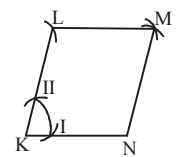
(a) 45°
(b) 60°
(c) 120°
(d) 135°
 View Answer
View AnswerAns: (b) 60°
Q34: To construct a kite which of the following is necessary?
(a) Two adjacent unequal sides and included diagonal.
(b) Two adjacent equal sides and included diagonal.
(c) Opposite sides length.
(d) None of these.
 View Answer
View AnswerAns: Two adjacent unequal sides and included diagonal means two unequal sides and diagonal from common vertex, i.e., sides AB, AD and diagonal AC are given. 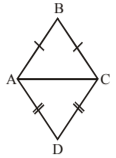
Q35: In the diagram, KLMN is a constructed parallelogram.

Find the value of ∠KLM.
(a) 15°
(b) 30°
(c) 45°
(d) 60°
 View Answer
View AnswerAns: (c) ∠KLP = 90°
LM is an angular bisector of ∠KLP
∴ ∠KLM = 1/2 × 90° = 45°
Everyday Mathematics
Q36: Given below are the steps of construction to construct a quadrilateral ABCD where AB = 5.6 cm, BC = 4.1 cm, CD = 4.4 cm, AD = 3.3 cm and ∠A = 75°. Which of the following is INCORRECT step?
(P) Step I: Draw AB = 5.6 cm and construct ∠BAX = 75°
(Q) Step II: With A as centre and radius = 3.3 cm, cut off AD = 3.3 cm along AX.
(R) Step III: Join BD. With D as centre and radius = 4.1 cm, draw an arc.
(S) Step IV: With B as centre and radius = 4.1 cm, draw an arc to cut the arc drawn in above step at C. Join BC, CD to obtain the required quadrilateral ABCD.
(a) P
(b) Q
(c) R
(d) S
 View Answer
View AnswerAns: (c) R
Q37: If AB = 7.3 cm, one angle is 60° and diagonal bisect each other at 90°, then which of the following figure can be constructed?
(a) Rectangle
(b) Square
(c) Trapezium
(d) Rhombus
 View Answer
View AnswerAns: (d)
Here, one side, one angle 60° and diagonal bisect each other at 90° is given and we know that diagonals of a rhombus bisect each other at right angle. So, a rhombus can be drawn since one angle is 60°.
Q38: Given below are the steps of construction of a quadrilateral ABCD, where AB = 3.5 cm, BC = 6.5 cm, ∠A = 75°, ∠B = 105° and ∠C = 120°. Which of the following is a wrong step?
(P) Step I: Draw AB = 3.5 cm.
(Q) Step II: Draw ∠XAB = 75° at A and ∠ABY = 105° at B.
(R) Step III: With B as centre and radius BC = 6.5 cm, draw an arc to intersect BY at C.
(S) Step IV: At C draw ∠ADC = 120° such that CZ meets AX at D.
(a) P
(b) Q
(c) R
(d) S
 View Answer
View AnswerAns: (d) S
Q39: Given AB = 3 cm, BC = 5 cm, AC = 9 cm, AD = 6 cm, CD = 2 cm. Which of the following is true about the construction of a quadrilateral?
(a) It is possible to draw the quadrilateral.
(b) It is not possible to draw the quadrilateral since AD + DC > AC.
(c) It is possible to draw the quadrilateral since AD + DC < AC.
(d) None of these
 View Answer
View AnswerAns: (b)
Here, it is given that AD + DC < AC which does not satisfy triangle inequality and hence quadrilateral cannot be drawn.
Q40: The construction of which figure is shown in the diagram?
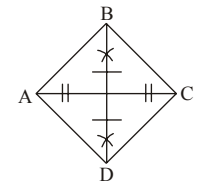
(a) A trapezium
(b) A rhombus
(c) A rectangle
(d) A kite
 View Answer
View AnswerAns: (b)
Diagonals and bisecting each other at right angle.
Q41: Where is the circumcenter of a right triangle located in relation to the triangle?
(a) On the triangle
(b) Outside the triangle
(c) Inside the triangle
(d) The location varies
 View Answer
View AnswerAns: (a)
On the triangle
Q42: You are looking at a triangle where the orthocenter, the centroid and the circumcenter are all the same point. What type of triangle are you looking at?
(a) Scalene
(b) Isosceles
(c) Equilateral
(d) Right
 View Answer
View AnswerAns: (c) Equilateral
Q43: When constructing a line parallel to a given line, you will be
(a) copying a segment.
(b) bisecting a segment.
(c) copying an angle.
(d) constructing a perpendicular.
 View Answer
View AnswerAns: (c) Copying an angle
Q44: The centroid of a triangle is located 12 units from one of the vertices of a triangle. Find the length of the median of the triangle drawn from that same vertex.
(a) 16
(b) 18
(c) 24
(d) 36
 View Answer
View AnswerAns: (b)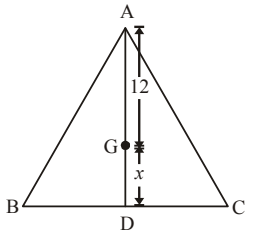
Let AD be the median of △ABC.
Let G be the centroid of △ABC.
Let GD = x unit
∴ Length of median = 12 + x.
Since centroid divides median in 2 : 1 ratio.
∴ 12 : x = 2 : 1 Hence, length of median = 12 + 6 = 18 units.
Hence, length of median = 12 + 6 = 18 units.
Q45: The diagram shows the four quadrants P, Q, R, and S on a Cartesian plane.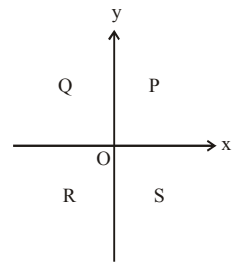
Which of the following points lie in quadrant S?
I (–1, 2)
II (–1, –2)
III (1, –2)
IV (2, –1)
(a) I and II only
(b) I and IV only
(c) II and III only
(d) III and IV only
 View Answer
View AnswerAns: (d)
In S, the abscissa of a point is positive, and the ordinate of a point is negative.
Thus, (1, –2) and (2, –1) will lie in quadrant S.
Achievers Section
Q46: If the coordinates of the two points are P(–2, 3) and Q(–3, 5), then
(Abscissa of P) – (Abscissa of Q) is:
(a) 5
(b) 1
(c) 2
(d) –3
 View Answer
View AnswerAns: (b)
(Abscissa of P) – (Abscissa of Q)
= –2 – (–3) = –2 + 3 = 1
Q47: The distance of the point P(4,3) from the origin is:
(a) 5
(b) 4
(c) 7
(d) 3
 View Answer
View AnswerAns: (a)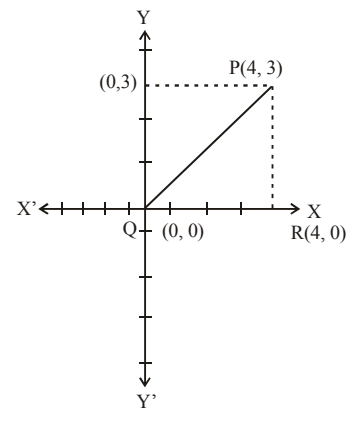

Q48: The diagram shows a straight line MN.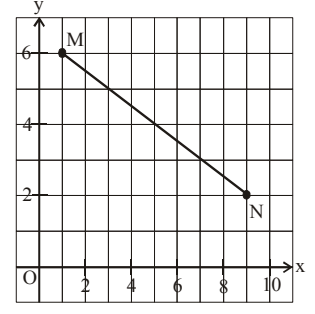
Which of the following coordinates does not lie on the line MN?
(a) (1, 6)
(b) (3, 5)
(c) (4, 5)
(d) (7, 3)
 View Answer
View AnswerAns: (c) (4, 5)
Q49: The graph below compares the price (in Rs) and weight of 6 bags (in kg) of sugar of different brands A, B, C, D, E, F.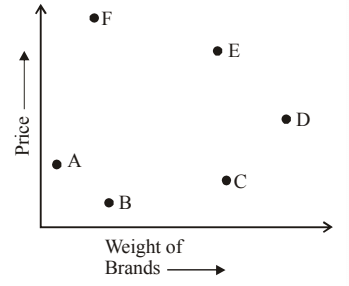
Which brand(s) costs more than Brand D?
(a) E and F
(b) E and C
(c) F
(d) E
 View Answer
View AnswerAns: (a)
We can see that points E and F lie above point D.
So, brands E and F cost more than brand D.
Q50: Observe the adjoining graph and answer the following questions: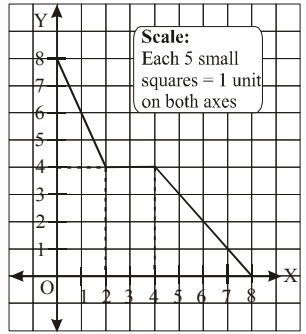
(i) Changes in y when x changes from 0 to 2.
(a) 2
(b) 4
(c) 0
(d) –4
(ii) Change in y when x changes from 2 to 4.
(a) 0
(b) 2
(c) 4
(d) 3
 View Answer
View AnswerAns:
(i) (d) Graph decreases steadily from 8 to 4.
(ii) (a) There is no change in Y.
|
24 videos|57 docs|100 tests
|
FAQs on Mathematics Olympiad Previous Year Papers - 3 - Mathematics Olympiad Class 7
| 1. What topics are covered in the Class 7 Mathematics Olympiad Previous Year Papers? |  |
| 2. How can students prepare for the Class 7 Mathematics Olympiad effectively? |  |
| 3. What is the format of questions in Class 7 Mathematics Olympiad exams? |  |
| 4. Are there any specific strategies for solving Logical Reasoning questions in the Olympiad? |  |
| 5. How important is time management during the Class 7 Mathematics Olympiad? |  |





















